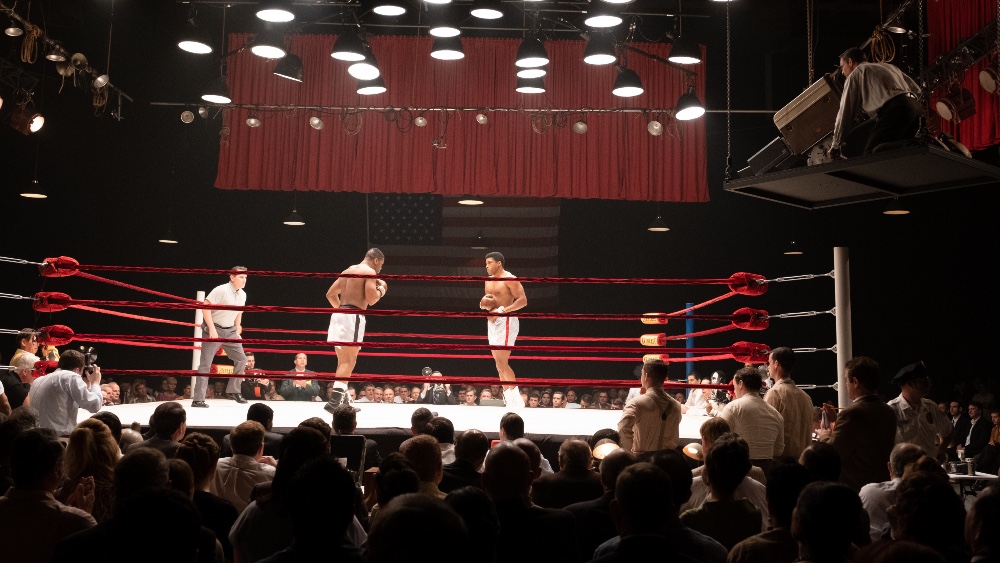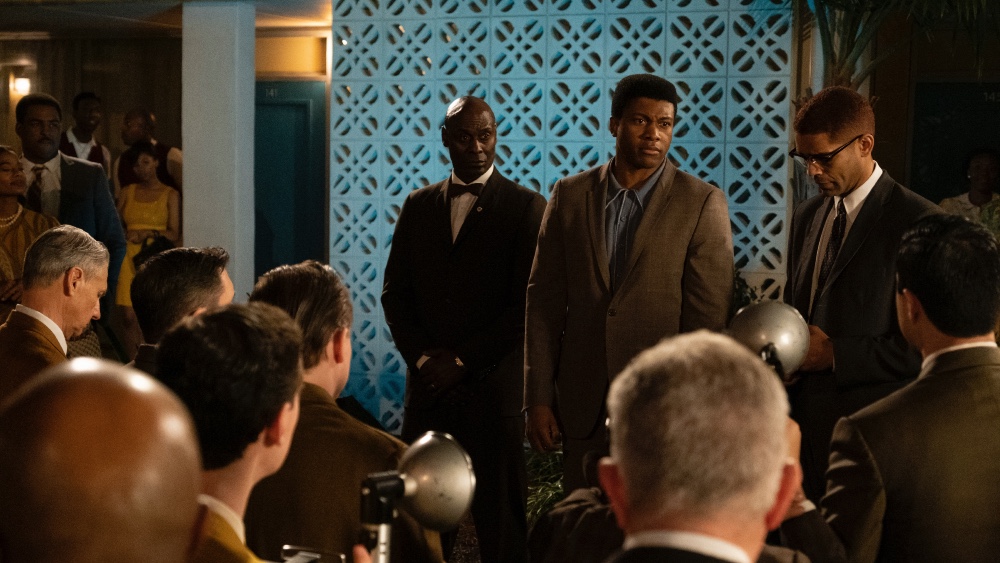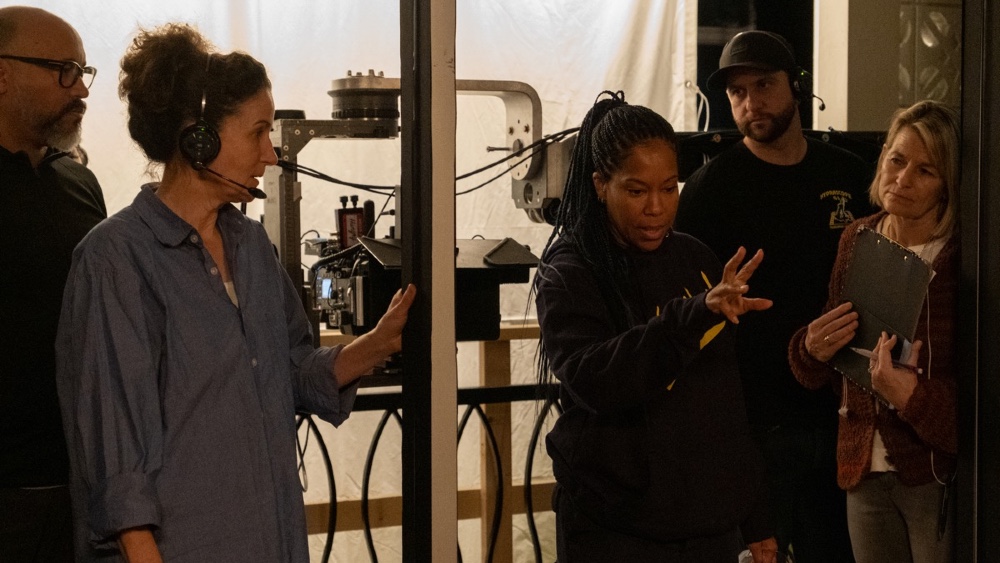
Anyone who has seen Regina King’s film One Night in Miami… will surely be impressed by Kemp Powers’ script and the performances by Kingsley Ben-Adir, Leslie Odom, Jr., Eli Goree and Aldis Hodge as ‘60s icons Malcolm X, Sam Cooke, Cassius Clay and Jim Brown, respectively. It doesn’t take long after that to notice how amazing the entire film looks, as it tells a fictionalized story of the four men celebrating Clay winning the championship in the titular night. The movie is based on Powers’ original play, but the team King put together has made it flow and move in ways that just can’t be done while watching four actors on a stag.
Despite only having ten movie credits in her resumé, Cinematographer Tami Reiker, ASC, is no newbie, having shot a variety of projects since 1995, even being nominated for an Independent Spirit Award for shooting Lisa Cholodenko’s indie film High Art in 1998. In fact, she’s worked fairly regularly with filmmaker Gina Prince-Bythewood, having recently shot her Netflix action movie, The Old Guard, starring Charlize Theron.
There’s no question that Reiker’s camerawork and lighting choices contributed greatly to why King’s feature debut as a director looks so great and keeps the viewer invested despite mostly taking place in a single hotel room and being so dialogue-driven. Then again, you also get to watch a young Cassius Clay boxing and a few amazing recreations of performances by Odom Jr. as Cooke.
Below the Line spoke with Ms. Reiker over the phone late last year for the following interview:
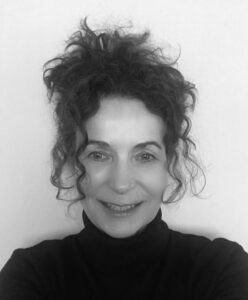
Below the Line: It’s nice talking with you. Unfortunately, I haven’t had a chance to watch your movie on the big screen, since I’ve had to watch everything on my laptop this year.
Tami Reiker: Oh, I know, but as a cinematographer, you’re like, “Oh, the laptop looks the best?”
BTL: What was your background before shooting High Art and some of your earlier films? Did you go to film school or were you a photographer?
Reiker: I always had a passion for still photography. That’s how I started, and then I went to NYU Film School, and that really kicked it off. After that, I started shooting a lot of student films in New York City and a lot of Columbia grad films, that’s where I met Lisa Cholodenko, and shot High Art. I was in that independent film world scene in New York City back, then shot a lot of music videos.
BTL: You went from indie film into television, and you tend to bounce back and forth doing different things. Do you have a preference or is it just what comes up and whether it fits your schedule?
Reiker: Yeah, and being a Mom, a lot of it is how it all fits in with your life. I’ve shot a lot of pilots for television — I’m working right now on a pilot, which I love. You’re creating the look of the show, and you’re just shooting the first episode. But I love shooting feature films, also.
BTL: I know you’ve worked with Gina Prince-Bythewood quite a bit, but had you shot anything that Regina had done as an actor or as a director doing television?
Reiker: No, this was the first time I worked with Regina.
BTL: How were you connected with her? Had she seen your other work?
Reiker: She had seen my work, and the producers connected us. She liked my reel, and I came in for an interview and presented a look book, and we just had a great meeting. And then, that was that, and I was off to New Orleans with her.
BTL: What were some of your early conversations with her besides showing her the look book. What references did either of you have for how to shoot the film?
Reiker: We discussed a lot of the references from the three photographers that I had presented to her for the look of the film. We both really wanted a very rich and saturated film, very vibrant. The main conversation was really about how do we turn this play into an exciting feature film and honor Kemp’s dialogue without having the camera takeover. Over half the film takes place in a hotel room, so a lot of our discussion centered around how would we keep the camera alive and keep it floating. I presented this idea of using two jib arms, so we could keep the camera floating between characters, so that it would not detract from the action, but it would have a fluid movement. We wanted sort of perpetual motion in the film, so that experience would feel more powerful. They would always keep drifting slightly.
BTL: The editing and camerawork added a lot, because I’ve seen a lot of plays turned into films, and there’s always a danger of going overboard with the camerawork to make up for that fact, but here, just capturing those performances in a way that you have enough for the editors to work with in post.
Reiker: Yeah, yeah, give the editor the most. The dialogue is so intense and powerful that you didn’t want to completely be a fly on the wall, but you wanted the audience to have this immersive experience and feel like they were in the hotel room with them. Which I feel like it does. I’ve seen it so many times, but towards the end, when you’re in that room, it’s so intense and powerful.
BTL: What sort of references were you using? There must have been a lot of pictures of the guys, like Cassius Clay, from the time in which the film takes place.
Reiker: Yes, it was really important to Regina to stick to the actual events and locations so historical references were really important to her. For the fighting scenes, besides watching the actual fight, the Ali GOAT book became our bible for those fight scenes. We recreated the entire lighting grid that actually was at the Miami Convention Center. For costumes, for extras, everything, studying notes, photographs, and getting it as historically accurate as we could became really important. Also, for Ali, the photographers Neil Leifer and Howard Bingham followed him through most of his career, so we had all of those photographs. For Malcolm X, Eve Arnold had some amazing photographs. We used those references for framing and in the life of Malcolm X.
BTL: You mentioned this Ali book, so did that talk a lot about the lights they used when they shot the matches?
Reiker: We could just see from the photographs – the Ali GOAT book has incredible photographs, so we duplicated the whole lighting grid above the exact scoop lights, these old Altman 1k scoop lights that the gaffer found, collecting dust in some warehouse. We were able to build the same lighting grid that actually existed in the Miami arena.
BTL: Did you shoot in the same arena?
Reiker: No, we had the same stage, but the lighting grid above it. When the photographer shoots, they’re shooting up into the light. You can see the whole grid.
BTL: That would have been amazing if you were able to find any of the locations looking like they did 60 years ago.
Reiker: For the Hampton House, it still exists in Miami, so we had a lot of photographs, and we had our location scout go down there and take pictures of the actual Hampton House. When Barry, the production designer, he found a hotel about an hour and a half outside New Orleans that we could take over, and he was able to paint it and do construction to make it as close as possible to the actual Hampton House.
BTL: How closely do you work with other departments while prepping, particularly hair and makeup and costumes, but also that hotel room, which has very specific lighting.
Reiker: In prep, Regina, Barry [Robison] the Production Designer; and Francince [Jamison-Tanchuck], the Costume Designer; and myself – the four of us were constantly having meetings and on Zoom calls and sharing references of the color palette, which were so important. We were all sharing colors of gels and the paint samples and bedspreads and the incredible sharkskin suits that she had made. We were all constantly sharing everything, so we were on the same page with the color palette.
BTL: What kind of prep time did you have for this? I’m sure the rehearsal was a whole thing in itself but just to have the space ready to film in.
Reiker: We had four weeks prep — not very much — actually surprisingly, there was very little rehearsal, because these actors were coming from all different places and different films and TV shows. Regina really only got the actors the day before, and we started with the hotel room. That was one of the really challenging things, because there were like 10 and 12-page dialogue scenes, just wall-to-wall dialogue. Amazing dialogue, that’s just a lot to tackle, and we found a way of shooting where we would shoot the entire scene through all the masters and the coverage. The actors actually really liked ramping up and doing the whole scene, as opposed to just doing a pickup of just the end, or just this line, or just the beginning. It was very interesting and challenging. We had walls that pulled, and behind every mirror or painting in the hotel room was a cutout bowl, so the camera could poke through and that we could keep shooting with two cameras the whole time.
BTL: I was curious about that, because when I was watching, I wasn’t sure if they were doing an entire four-minute scene each time. All the scenes are fairly long.
Reiker: Yeah, we did. So we would cover the whole scene from one side of the room with two to three angles and tighter, but even when we went tighter, we would still cover the entire scene, and then go around and pull the walls on the other side and shoot it that way. I think that really for the editor and everything having that continuity of each time the entire scene was filmed made it very interesting, especially up on the roof. It’s a really long scene, and we shot outside at night. Barry, the production designer, we couldn’t find a roof. Regina and I absolutely wanted to shoot outside and not green screen or blue screen on a stage, but every roof that we found was too high and the actors would have to be on wire, because it didn’t have a safety railing. So Barry built that roof on shipping containers right outside of the stage, and it worked out really beautifully. We still had to put a small thin railing up for safety, but it kind of just disappears, and we had 280 degrees of darkness and the gaffer and I just put pinpoints of light at the quarter mile out all around, so you would still feel some life out there. In visual effects, they created the Miami skyline and the fireworks.
BTL: Where did you end up shooting this?
Reiker: The film was shot in New Orleans, but this actually was shot at a place called LaPlace, Louisiana, which was an hour outside New Orleans.
BTL: There are so many different locations, and I assume you didn’t go to Boston or any of those places.
Reiker: No, that was a theater in New Orleans. We had two days left of shooting that we did in Los Angeles, but we were shut down by COVID, so we didn’t pick those up until mid-June right when filming started up again in L.A., because the film was going to the Venice Film Festival, so it’s a big rush to get everything finished and the color timing and the music and soundtrack and all of that.
BTL: I was gonna ask whether COVID affected the shoot at all and if you had to come back and do more.
Reiker: The bulk of it was in New Orleans but then because we finished at the end of February, and we all came back to L.A., and we were going to shoot in March the Fountain Bleu hotel room and the liquor store, and then everything got shut down. Regina continued editing with Tariq [Anwar] remotely, and then when we were able to film again, we shot in Long Beach. We found a liquor store and a stage where we built the hotel room. The color-timing in August, we were all able to be in the same room together.
BTL: I’ve spoken with a few DPs over the past few months talking about how they color-timed using an iPad Pro and how post has shifted remotely.
Reiker: What was really great is that we did the color timing at Light Iron, and the colorist was in a separate theater, but the producers and Regina and myself, we’re all in the same theater together, and we had an iPad and through Google Hangout, we were able to talk to him. We were watching the same image real time, but it was also amazing because we were able to send the image that we would be talking about to all the visual effects, because they were all over the world, a lot of them were in France, in England. There was some in LA, some in New York, and we were all able to be on the same call. We’re sitting in the theater and they’re watching the same image, and we can all talk through the visual effects as they’re coming in.
BTL: I guess visual effects has always been like that since the houses are all over the world, so the pandemic has made it easier by creating new ways you can do that stuff.
Reiker: Yeah, certain things like that – like all the things with Zoom and all the meetings we’re having over Zoom. Some things are always going to be better in person, but things like that, to have access and everyone watching the same image at the same time was fantastic.
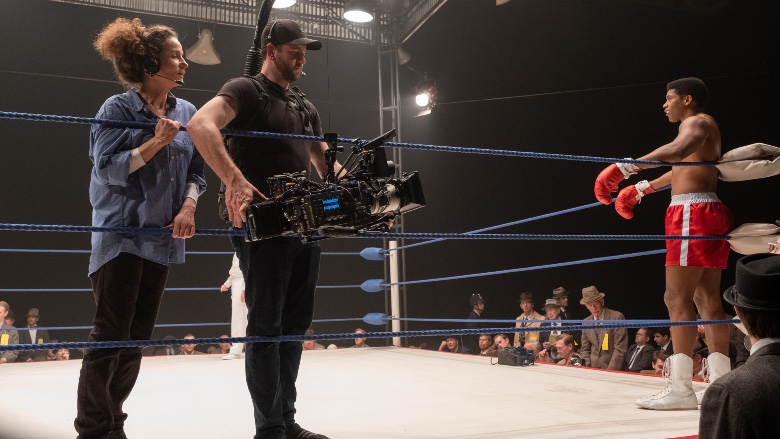
BTL: Did you and Regina shot list everything with storyboards or was a lot of it decided on the day?
Reiker: Not for the hotel room. All the fight scenes were storyboarded in detail and some of the other scenes – the Boston ballroom – but for the hotel, no, it was much more fluid. We would watch rehearsal, and we’d come up with our plan. We were always looking for moments when we can drift from character to character, so the film wouldn’t be so “cutty,” so that if one person is talking, the focus would wrap and the camera would drift over to another character. After we would shoot a master, we would always, each take, run back to each other. I would be at the VIP tent, she would be at her director’s monitor. A lot of amazing things were discovered in those first couple masters, and then, when we went in for coverage, we would just push even harder on that. The two operators were on headsets, so I could talk to them throughout, so that they could drift from character to character or on certain takes, try something new.
BTL: Do you usually use the same camera team or try to at least? Or do you work with whomever is in the area where you’re shooting?
Reiker: On this film, I brought my first AC from L.A., but the operators and the rest of the crew were new to me, and they were fantastic. They were all from New Orleans. because there wasn’t a big budget, so we had to have local crew, and New Orleans has an incredible crew. There’s so many good films shot there now.
BTL: I guess when you’re working on television, you’re putting together a team that will continue onto the rest of the series.
Reiker: Yeah, absolutely. You get to usually bring one person with you that you know, and otherwise, everyone’s new to you.
BTL: You mentioned you went back for pickups in L.A. in August, so how different was it to shoot those scenes with the new COVID rules in place?
Reiker: On the stage, it was actually fine. It was a little tricky outside with all the extras. I mean, we were just putting all these COVID rules in place as we were coming back. I mean, it all worked fantastic, especially in the energy everyone wanted after everything that had happened over the break with George Floyd and “Black Lives Matter.” It was just so important to everyone this film just some had to come out now. So all that energy from everyone just made it work.
BTL: The timeliness of the movie and relevance of when it came out is great. I’m not sure when Kemp’s play was first staged…
Reiker: Three years ago, but you’re watching it now, and the word’s that they’re saying are so relevant and powerful, and you’re just also like, “Wow, nothing’s changed, you know?” This was 40 years ago, and the fight is still the same.
BTL: Have you started prepping anything to start filming something else soon?
Reiker: Right now, I’m in Mississippi, prepping for an amazing TV show called, Women of the Movement. It is about Emmett and Mamie Till, telling the story of Emmett Till and his mother Mamie who fought for civil rights.
BTL: Who’s directing that?
Reiker: Gina Prince-Bythewood. We’re based out of Greenwood. Amazing location, it’s really incredible.
BTL: I go down to Oxford every couple years, and as someone who has lived in New York for so long, it’s really eye-opening. I mean, there are so many big houses with multiple floors.
Reiker: Right, right, and then compared to New York or L.A., the director and I are staying in this beautiful, old house, and I’m like “Oh, my God. I just went on Zillow. Guess how much this house is selling for?” and she goes, “2 million?” I’m like, “$320,000.” [laughs]
You can watch One Night in Miami… on Amazon Prime Video. Also, check out our interview with Production Designer Barry Robison and our earlier review. Look for an interview with Editor Tariq Anwar soon.
All photos courtesy Amazon Home Video.

